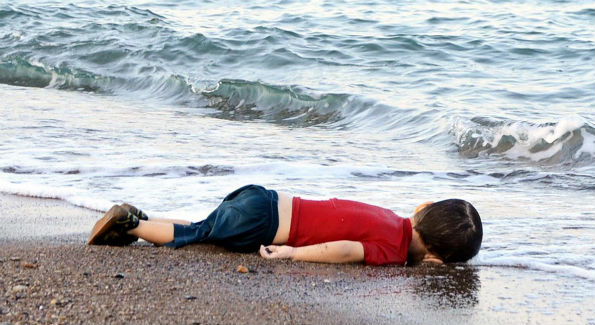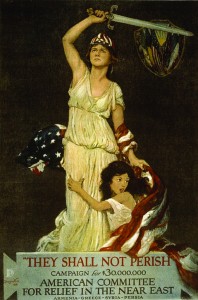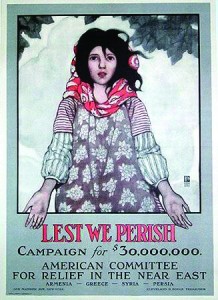The Near East Foundation marks 100 years of influencing American giving abroad.

This photo of young Syrian boy Aylan Shenu drowned on a Turkish beach, after a boat carrying refugees to the Greek island of Kos sank, sparked outrage around the world. It was a wake-up call for many to do something, a tragedy that captured the severity of the worst migrant crisis since World War II. (Credit: AFP Photo/Nelufer Demir/Dogan News Agency)
As we are all overwhelmed by the recent tragic images of families escaping violence in the Middle East and wondering what we can do to help, we are reminded of the first major outpouring of American humanitarian support abroad following the fall of the Ottoman Empire, and the mobilizing power of America’s first non-governmental relief organization. Before the Peace Corps and USAID there was the Near East Foundation.

NEF’s ad campaign materials forever changed the landscape of philanthropic fundraising (Poster by Douglas Volt, 1918)
Now in its centennial year, the NEF holds the honor of being the second Congressionally-chartered nonprofit (the first was the American Red Cross), receiving this distinction in 1919. In 1915, Ambassador Henry Morgenthau sent a cable to the U.S. Department of State declaring that the “destruction of the Armenian race is progressing rapidly” and urging something be done. The refugees he was pleading for included more than 132,000 orphans whose parents were killed during the genocide and deportations that claimed the lives of nearly three million Armenians, Greeks and Assyrians from 1915 to 1923 in what is now Turkey and Syria.
Two weeks after Morgenthau’s call to action, a group of civic, business and religious leaders, led by Cleveland Dodge and James Barton, formed a committee to lead the response to the tragedy. By the end of their first meeting, attendees had pledged $100,000 to send to the region. Between 1915 and 1930, they would raise more than $116 million (over $2 billion in today’s dollars) for emergency relief and services, providing aid to refugees both during and after the collapse of the Ottoman Empire. The extraordinarily successful rescue mission included the creation of orphanages to care for thousands of children. Prominent American families stepped up to the plate to offer assistance, among them the Dodge, Heinz, Pillsbury, Morgenthau, Roosevelt, Rockefeller and du Pont families.

NEF’s campaign techniques became a model for other philanthropic organizations. Campaign materials used vibrant colors, memorable images and catchy slogans to generate attention (Photo by Dan Smith, 1935)
“It was unique and unprecedented because people from every sector of society — business, clergy, academia, government, philanthropy — collaborated to lead the effort together,” NEF’s President Charles Benjamin says. “Under the leadership of James Barton and Cleveland Dodge, whose great-grandson represents the family on NEF’s board today, the relief effort saved more than a million lives.”
It was also the first time in American philanthropic history that an organization appealed directly to the public to support humanitarian work overseas, giving birth to what is called “citizen philanthropy.” Fundraising and publicity tools that are now ubiquitous were first formed by NEF. Posters with captivating images called for donations; one from a 1917 campaign juxtaposed illustrations of suffering women and children with appeals for $30 million to aid “The Child at Your Door: 400,000 Orphans Starving.” Patriotic images in other posters suggested it’s America’s duty to protect children. The recent heartbreaking photograph of the Syrian boy on the beach brings to mind the powerful images utilized by NEF to mobilize Americans to action nearly a century ago.
In keeping with this founding spirit, the theme of NEF’s centennial gala is “Celebrating 100 Years of American Humanitarianism Abroad.” On Oct. 28 at Cipriani Wall Street in New York, NEF’s board of directors and committee co-chairmen will join representatives of NEF’s “founding families” (those who worked with the organization in the early years and were key in shaping its work, including the Dodge, Morgenthau, Kerr, Wilson and Hoover families); foreign diplomats; NEF partners and supporters to reflect on the strides made over the years and toast the next hundred years of life-saving initiatives. Proceeds from the gala will go towards NEF’s work with Syrian and Iraqi refugees and their host communities, honoring NEF’s legacy through action to address the crises of our day.
“With humanitarian aid decreasing and the crisis worsening,” Benjamin says, “there is a greater need than ever for long-term solutions to reinforce self-sufficiency, protection and economic resilience.”
For the full article and how you can help, read our special feature in the October 2015 issue of Washington Life magazine below.




